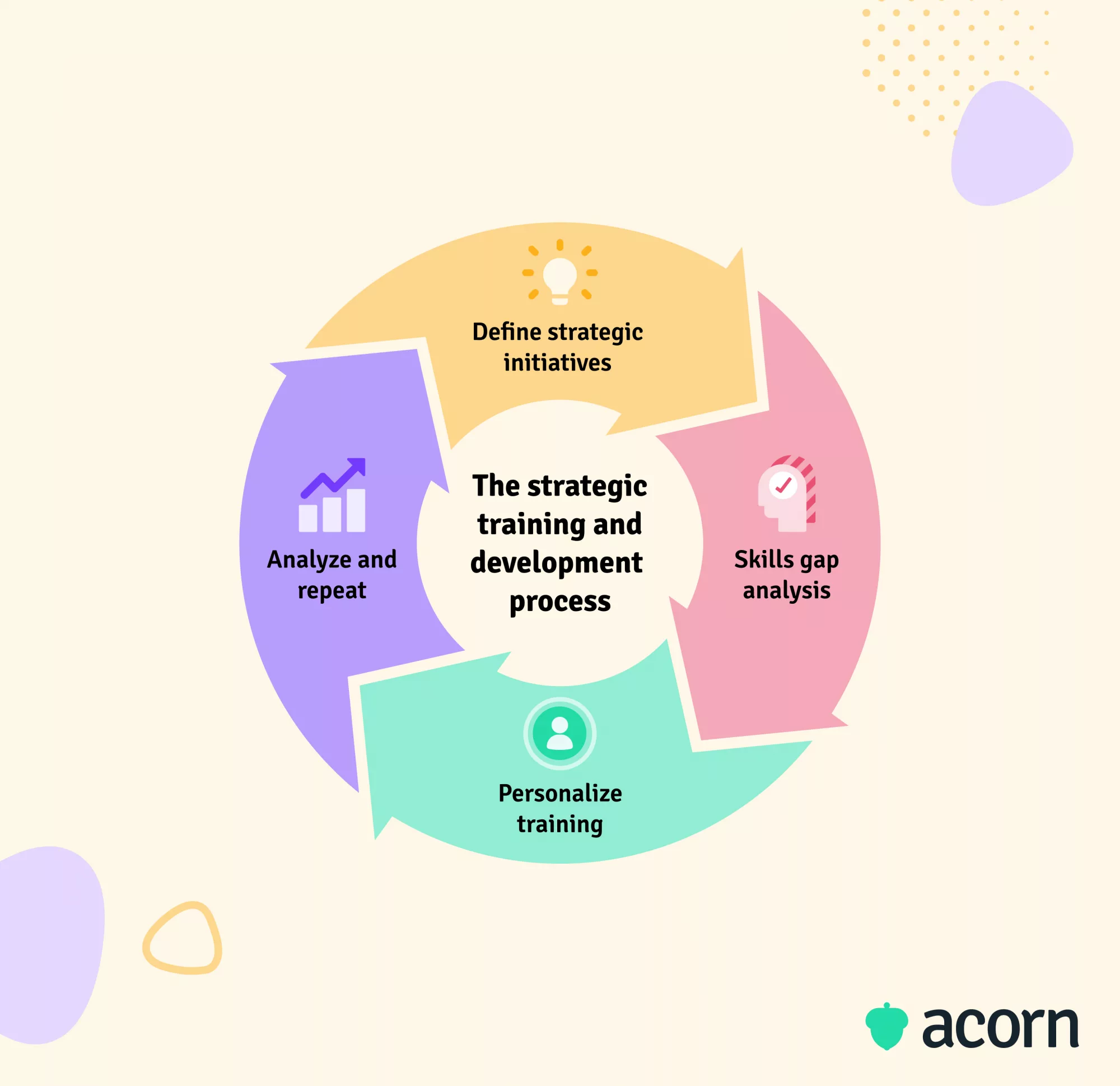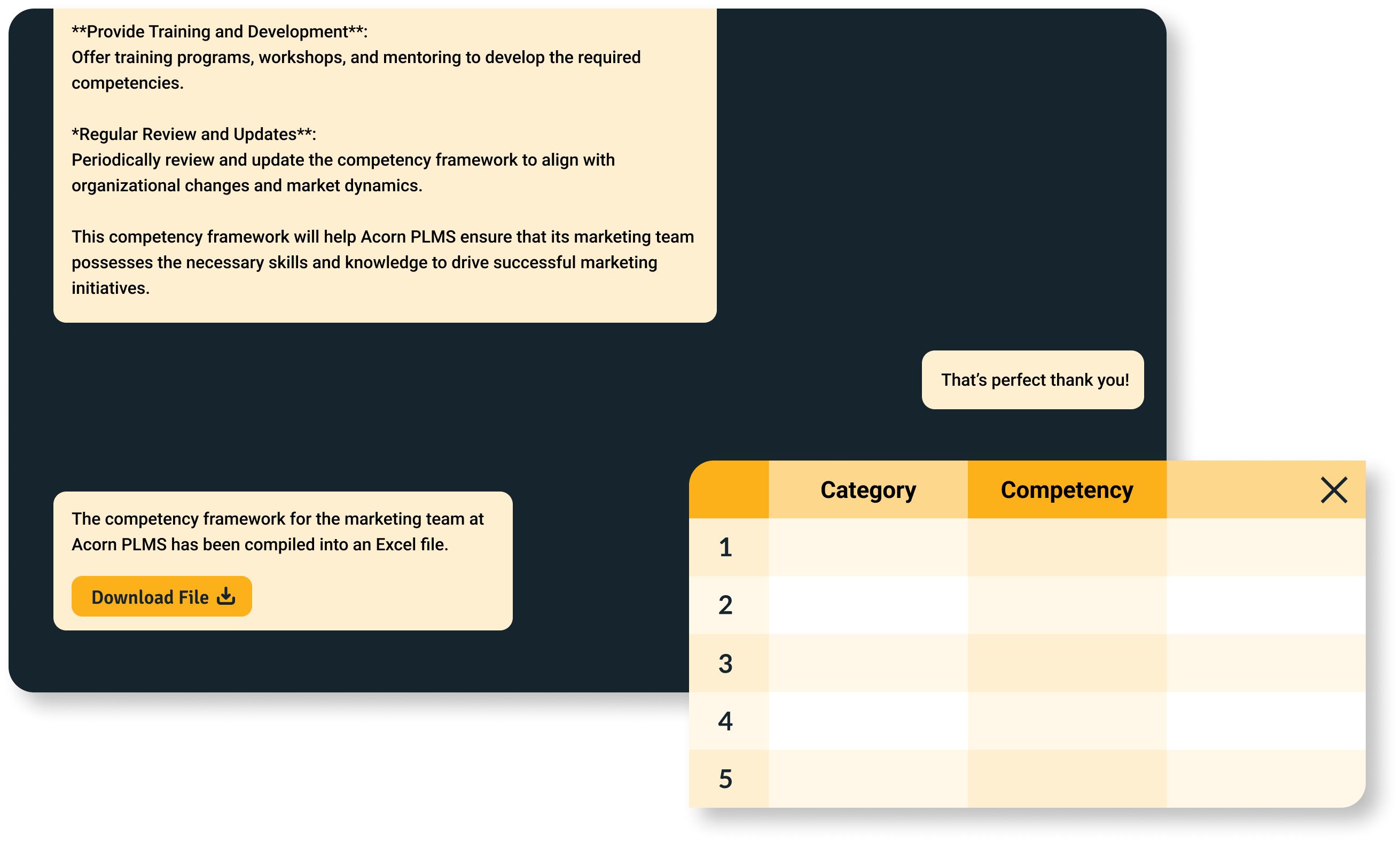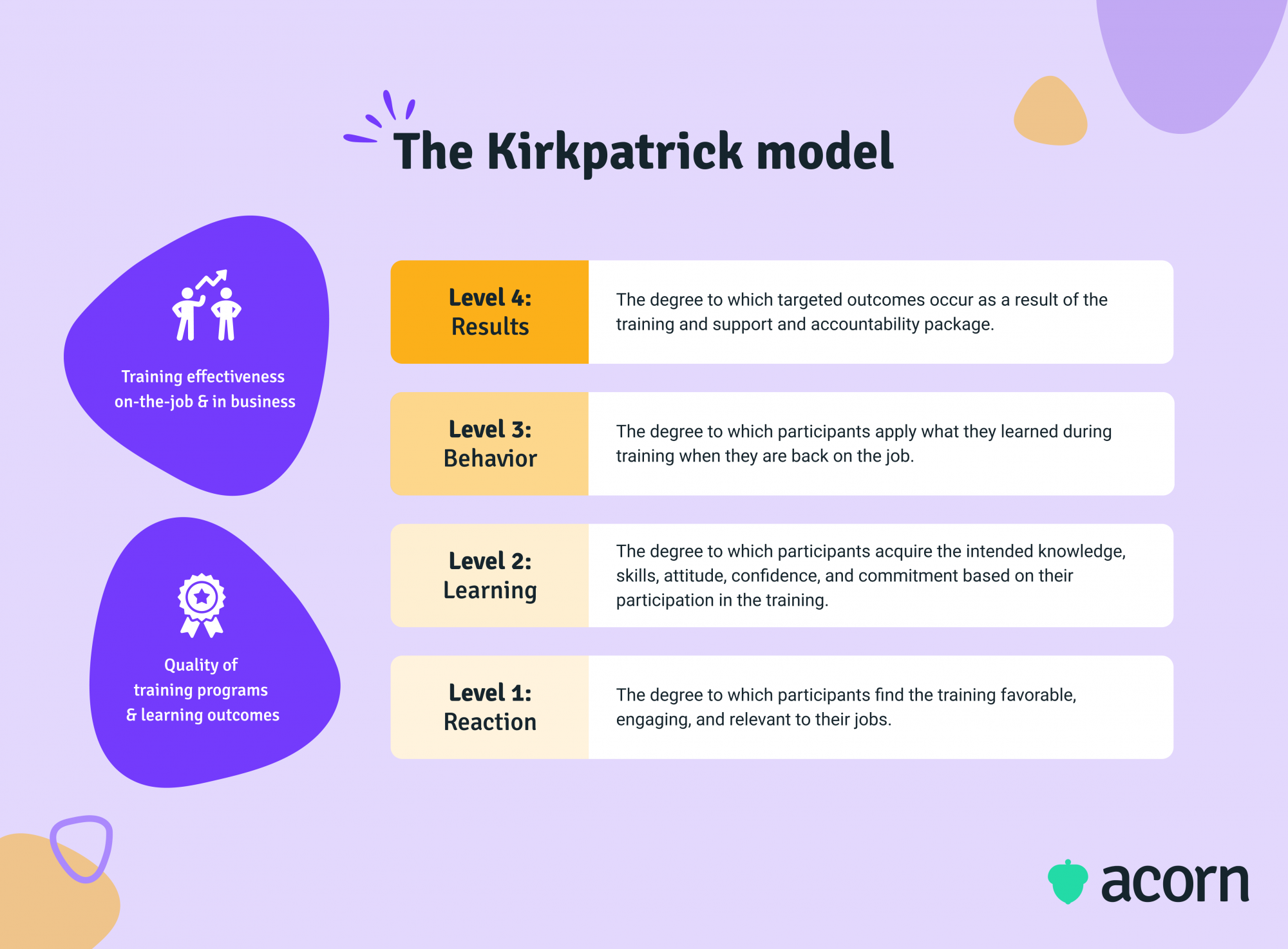Why Strategic Training and Development is Essential for Long-Term Business Success
Reading Time:

Lead the pack with the latest in strategic L&D every month— straight to your inbox.
SubscribeStrategic training and development is a vital factor in the long-term performance of any company.
Training programs come in many forms, depending on the organization. What all should have in common is a strategic focus—that is, the company goals the program will impact.
Strategic training and development ties individual learning needs to business results. Not only does this give employees a better sense of purpose, it ensures that job roles and everyday work are truly driving business success.
Let’s walk through the steps in the process as well as examples of strategic training and development you can implement today.
What is strategic training and development?
Strategic training and development is the process of designing specific employee training programs that directly align with business needs. Training with a strategic focus develops the capabilities and tools that employees need to effectively perform their jobs. In turn, the capabilities gained give organizations a competitive edge.
What is the strategic training process?
The difference between regular employee development and training with strategic goals comes down to a few characteristics.
- All development activities are based on the strategic objectives of the organization.
- The learning framework is general enough to be applied to any business function’s needs, but specific enough that it can address niche training requirements.
- Continual reporting, analysis, and iteration are a core part of the process for L&D professionals.
- Management acts as key champions.
- Training activities are tailored to personal needs to ensure learning sticks.
The above must exist and be routinely utilised in a strategic training process, particularly one that supports human resource management. At the centre is a performance outcome or behavioral change. Thus, the main differentiator is that strategic training and development programs are planned proactively and look long-term.
What are the steps in a strategic training and development process?
This process is always rooted in business-level outcomes. While you’re looking for performance outcomes at the individual level, these outcomes need to measurable business impact. Think of it as a cycle where each step informs the next, ultimately coming back to where you started.

Step 1: Define strategic initiatives
We need to start at the top: Business strategy. What is the ultimate business value that any given training program will provide?
If you don’t know what you’re trying to achieve, you can’t effectively identify or track results. And even if you do experience a positive result, you probably won’t be able to accurately retrace your steps to replicate it. This is why we want to have quantifiable training initiatives.
Look at your business drivers. Many organizations use capability frameworks to make these explicit. In the public sector, frameworks tend to emphasize high-level behaviors and attributes, while private enterprise frameworks tend to derive capabilities from technical, functional, and leadership needs.
Capabilities like customer management, decision-making, collaboration, and predictive analytics all tie directly to performance. The point isn’t to list skills; it’s to pinpoint the levers that move strategy forward. When you anchor training initiatives to these capabilities, you ensure development activity isn’t about ticking off course completions. Instead, it becomes a deliberate investment in the behaviors and tools employees need to deliver measurable outcomes. This is also why capability frameworks are so useful: they translate abstract business goals into a concrete map of what the workforce must be able to do, making it far easier to design training that sticks.

Yet to define your own capabilities? Get started in minutes (not months) with our Capability Assistant.
BUILD YOUR FRAMEWORKStep 2: Find your gaps
Once initiatives are clear, the next question is: Where are we now?
This is where capability gap analysis is critical. Rather than running a skills audit, you’re diagnosing capability maturity across four levers: people, process, information, and technology.
- People: Do employees have the proficiency, role clarity, and capacity to perform a capability effectively? For example, you may have excellent project management software, but if multiple managers lack experience coordinating cross-functional teams, the capability of Project Management is still immature.
- Process: Are workflows, governance, and accountability structures supporting the capability? A sales team may have great client skills, but still underperform if communication between marketing and sales is broken.
- Information: Is accurate, timely data available to support decisions and execution? Think of a customer service team trying to improve satisfaction scores without access to complete client histories.
- Technology: Does your tech stack enable the capability—or block it? Tools might exist but lack integration, leading to duplicate work or underutilization, or be entirely useless for your needs.
By assessing gaps this way, you can see the gap between current and target capability—and just as importantly, the causes behind it (something you can’t derive from skills). That prevents everything from being treated as a “training problem.” Sometimes the solution is developing people, but often it requires redesigning processes, improving data, or upgrading systems.
Related Read: Finding Workforce Gaps with Acorn’s Capability Gap Analysis Report, built just for this use case.
Step 3: Personalize activities
Armed with gap analysis, the next step is designing development activities that target the right capabilities in the right way. Training can be a change strategy, but only if it reflects how people work. Consider the day in the life of employees. What are they good at and why? Does a Technical Support Officer excel when talking with customers because they are empathetic, or because they understand the technology well enough to explain it? What are the blockages (new skills, processes, or technology) in their workflow? How do they structure their days?
Personalization at scale might seem daunting, but it starts with understanding what people need.
1. By role: A frontline customer service rep, an emerging leader, and the head of customers will face different capability demands, even within the same function. Training design should match the depth and complexity of the capability required.
- In practice: Customer service teams might get short scenario-based modules on handling complaints, while emerging leaders take part in mentoring programs focused on decision-making and delegation.
2. By workflow: Training has to slot into the way people work. Ask: Where in the employee’s flow of work will this capability be used? Then you can design learning to fit.
- In practice: If data analysis is a capability gap, design exercises using the company’s actual dashboards rather than generic click-through modules.
3. By career stage: High performers and future leaders need development that challenges them, while newer employees may need training that gives them the lay of the land.
- In practice: High performers might take on a stretch assignment leading a cross-functional project. Entry-level employees might focus on structured onboarding combined with peer coaching.
This is where managers are key. They should be openly discussing career progression and preferences with their employees (because managers directly impact the way training is viewed in the workplace culture), even co-designing the process.
This is where legacy learning tech is going to let you down. Most LMSs focus on plugging massive content libraries that force learners to wade through largely irrelevant content, where completion equals “success.”
It was this complaint that led us to create Acorn performance learning management system (PLMS): it maps learning content against the specific capabilities your workforce needs, turns everyday work experiences into learning assets, and reports on measurable impact. That way, training is always connected to performance and strategy.
Consider modes of training like:
- On the job training, such as mentoring, coaching, and job shadowing. These are effective for behavioral capabilities like people leadership, where translating theory into practice is critical.
- External learning through third-party providers, offering specialized expertise your business doesn’t yet have in-house. This also isn’t just for CPD; it helps you capture emerging industry practices without needing to immediately hire for them.
- Long-term study, such as graduate certificates or professional accreditations, for deeper technical capabilities. This doesn’t just have to be for graduates. Tenured employees can also benefit from totally new capabilities.
- Short-burst training, like video-based micro-courses, for just-in-time learning.
- Online training as accessed through a learning management system, providing on-demand content.
We’d recommend a blended approach, combining several modes into an experiential program. Letting employees select topics of personal interest can boost engagement, too, even when those capabilities aren’t immediately tied to their role. An IT professional exploring the psychology of product design, for instance, may uncover knowledge that enhances their day-to-day work.
Step 4: Analyze impact
This is the step that makes the process cyclical. It’s also where you show the ROI of training, proving if training hit the outcomes it was designed for.
Don’t just track surface-level indicators like course completions. Borrowing from the Kirkpatrick model, impact should be measured at multiple levels:
- Reaction: Did learners engage with the training?
- Learning: Did they gain the desired knowledge or capability?
- Behavior: Are they applying it in their daily work?
- Results: Did those behavior changes move business metrics (e.g., customer satisfaction, reduced rework, faster cycle times)?
The focus should always be on tangible outcomes that occurred—and only occurred—because of training.

However, there are ways you can use learning-based metrics like:
- Content completions
- Progression rates
- Performance reviews
To better understand organizational results such as:
- Customer satisfaction/complaints
- Employee satisfaction/engagement
- Project/process iterations.
For example, say support staff were trained in emotional intelligence. If customer satisfaction scores haven’t improved after three months, but completions were high, the issue isn’t employee engagement—it’s program design. That insight informs the next cycle.
Examples of strategic training and development programs
Before you dive into fleshing out a program, keep in mind that some training may not be strategic even if important to your business. Some types of training—like compliance, or onboarding—are essential for immediate needs. Strategic training looks longer-term, often weaving short-term initiatives into a bigger capability-building journey.
Initiative: Leadership development
Leaders are the core of workplace culture, which means any displays of agility, resilience and strategy filter down to employees. Equally, any negative attributes (poor delegation, opaque decision making, lacking business knowledge) will be obvious to those leaders are meant to influence.
Obviously, leaders aren’t just born or developed overnight. It takes time to grow leaders who are aligned to your business context, but the earlier you start, the easier it is to fill critical roles with people you’ve already developed.
Program: Mentoring
Leadership is something that is better learned than studied. Ergo, opt for a largely face-to-face approach that’s reinforced by online modules on topics like conflict resolution. Many great leaders will say experience is what sets them apart from junior roles, because experience provides context. Mentoring benefits both mentee and mentor, since it builds new knowledge in one and develops and reinforces skills in the other.
To make mentoring strategic, go beyond ad hoc pairings. Match mentees and mentors by capability gaps, personality, and experience. Managers should spotlight employees who are both high-potential and in need of guided development, ensuring mentoring is tied back to capability frameworks, not just personal preference.
Initiative: Social learning
Don’t knock it. Even at our most introverted, we are generally a social workforce. Think of the mission-critical knowledge that is shared in non-trackable ways: Between peers throughout the day, within meetings, on the coffee run.
Your competitive advantage is being shared here, without you even knowing or encouraging it. (Think about cross-cutting decisions.) But knowledge sharing depends on your culture; poor culture means knowledge is more likely to be siloed.
Program: Lunch & learns
Informal but impactful: that’s how we’d sum up the lunch and learn. Not all training needs to be extremely formal—social learning is an easy way of quickly improving employee knowledge.
Lunch and learns are low-cost, fast, and highly adaptable. They allow employees to share expertise across teams, provide cross-training opportunities, and bridge geographic gaps for remote teams through virtual sessions.
To make them more than “nice to haves,” tie topics back to business priorities. For example, a product team sharing insights on an upcoming launch doesn’t just educate peers—it improves readiness across the company. Equally, a communications team walking through marketing strategy can help customer-facing teams anticipate client needs. It’s also handy across remote workforces, where information is more likely to be scattered.
Initiative: Capability building
There’s not a lot to say here that hasn’t already been said. Capabilities—technical or soft, core or specialist—determine an organization’s long-term success. You can’t always hire for emerging skills fast enough, which is why continuously building them internally is a strategic must.
Program: Stretch assignments
Keeping high performers engaged is tricky. They learn and evolve quickly, so a challenge isn’t a challenge for long. Stretch assignments are often labelled soft promotions as they add dimension and responsibility to an employee’s job, while helping solve a business problem. While not entirely exclusive, it’s also something you can trial on a small group of employees—namely those who are starting to outpace their current role.
They’re truly impactful and easily implemented because they get employees on the ground. Training is practical, immediately or directly impacts the business and is reinforced by social sharing, making it low cost.
High performers, in particular, benefit from stretch opportunities because they develop faster than their current roles allow. Assignments can include:
- Leading a cross-functional project
- Relaunching or improving an internal initiative (like lunch and learns)
- Mentoring junior employees to practice leadership
- Representing the organization externally at client meetings or industry events.
The key is to design stretch work around both business needs and the individual’s capability gaps, so employees stay engaged while you grow the skills your strategy depends on.
Key takeaways
Training and development should never be done for the sake of it. The real value comes when programs are tied directly to business strategy. That way, employees aren’t just learning new skills, they’re developing the capabilities that sustain business performance and competitiveness.
Strategic training means:
- Aligning initiatives to long-term business goals through capability frameworks.
- Using capability gap analysis to identify where your workforce is today versus where it needs to be.
- Designing training that’s personalized, contextual, and practical — so employees can apply it immediately.
- Measuring outcomes at both the learning and business levels, then feeding insights back into the cycle.
When training is approached this way, it builds capability maturity across your workforce, strengthens job performance, and drives company-wide success.